Women in the workplace – a short history
Between 1930 and 1970, women’s participation in the US job market increased, particularly after the Second World War. Primarily driven by married women. There were several reasons for this:
- Increased emphasis on highschool education for women
- New technologies required more clerical workers to administer them, and women took on these jobs
- Clerical jobs were thought as cleaner and safer than manual jobs, and therefore more attractive for married women (and their husbands to agree to)
Discover how to make women and others feel safe in your organization
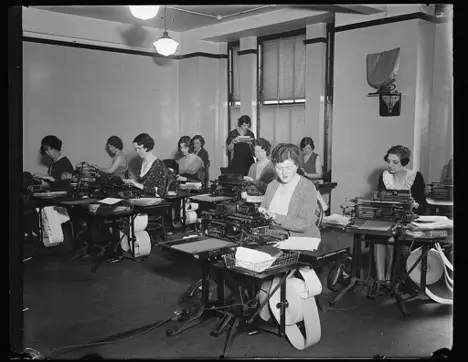
Initially, women’s working lives were short as they were considered ‘secondary earners’ compared to their husbands, and they were expected to give up work when they had a family. By the 1970s, though, women themselves were expected to spend more time working, and began to get educated and train for careers, rather than just jobs.
Societal changes such as access to contraception, which gave women more control of if or when to have children, and the right to apply for their own credit without a male co-signee, gave women more agency on their financial future Title VII of the Civil Rights Act of 1964 (‘Title VII’) made it illegal for employers to allow anyone to be sexually harassed at work regardless of sex, gender, or sexual orientation, and the 1978 Pregnancy Discrimination Act outlawed discrimination based on pregnancy, childbirth, and related medical conditions.
By the early 1990s, 74% of prime working-age women (25-54) were in the workforce, compared with 93% of prime working-age men, and more women were training and joining more traditionally male-dominated industries. However, women’s participation seems to have plateaued since then, and is currently at 76%, compared with 89% of men.
And while some women choose not to work, this historic gap in gender equality is wide enough to be a red flag that there are issues holding women back from participating in the workforce as fully as men do: the difficulties of combining career and family, a lack of equal opportunities, discrimination, and a dearth of female mentors.
And many women in the workplace are still being paid less than men – 17% less on average each week, and at least 10% less for women in the same or similar jobs as men, with the same experience and backgrounds.
Despite entering professional schools in equal numbers to men, women are statistically less likely to reach the top of their professions than their male counterparts.
We’re going to look at why.
What are issues for women in the workplace?
Organizations must understand the main challenges impacting women, then make changes that address the root cause of systemic issues, which are:
1. Discrimination
Yes, Title VII prohibits employment discrimination based on gender, race, colour, religion, or national origin, but laws don’t always protect people from more insidious discrimination such as microaggressions, unconscious bias or othering. These continue to affect women, especially women of color and transgender women.
- One study of female medics revealed that they experienced more inappropriate touching, sexual remarks, gestures, and suggestive looks than their male colleagues. Nearly all said that some patients assumed they were not doctors, and they felt that patients respected them less than male medics.
- Another study found that women leaders are twice as likely as male leaders to be mistaken for someone more junior.
Although federal law prohibits women in the workplace from being denied promotion because of gender, another study finds that women who showed early academic promise go on to have fewer leadership prospects at work, particularly when they become mothers. Men with lower academic grades (GPA) than women go on to achieve higher leadership roles, supervise more people, and this leadership gap is particularly acute when they become parents:
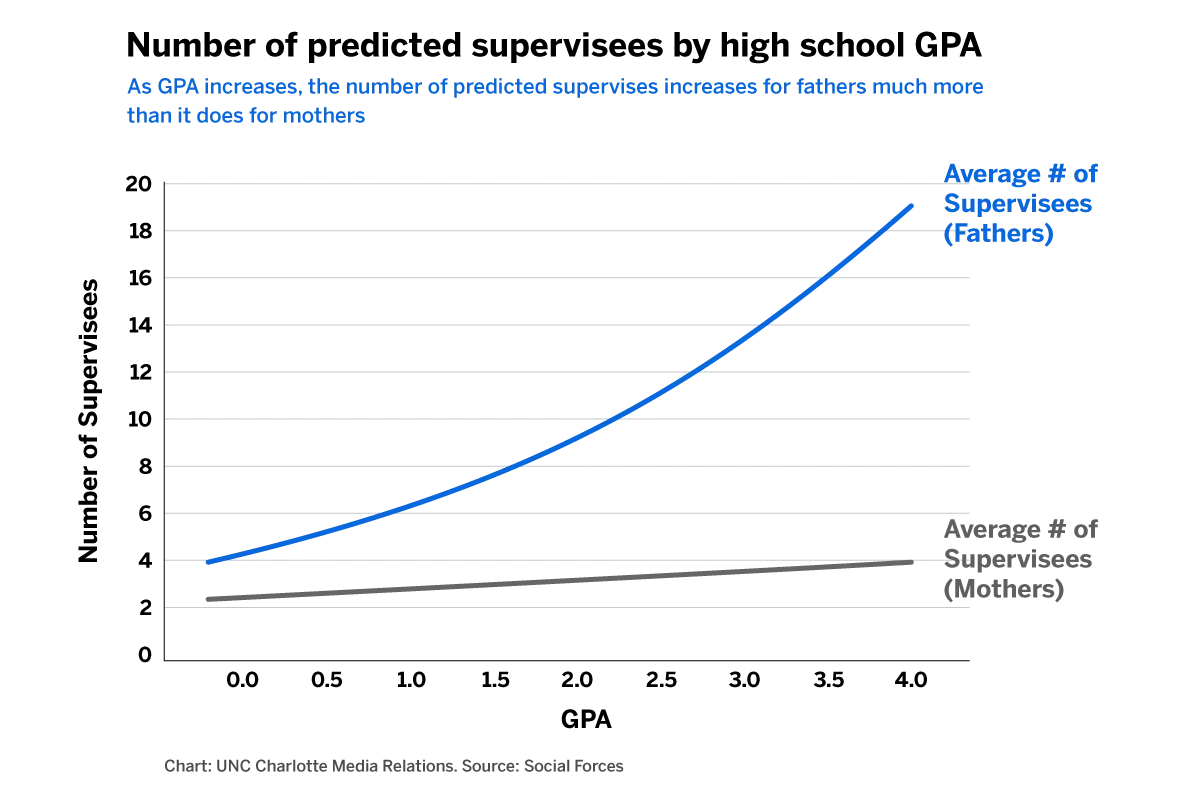
2. Caregiving responsibilities
A high proportion of women enter the workforce, yet we see a very low percentage in senior manager roles and at the top of organisations. What is the reason for this? So much comes down to the fact that women take most of the responsibility for caregiving.
Hybrid working helps to some extent, and research shows that only 1 in 10 women want to work mostly on-site, with many women saying that the opportunity for remote and hybrid work is a top reason for joining or remaining with an organisation.
However, it’s important to note that while women are remote working, men go into the office more than those women, and then there’s a problem because fewer women are visible. Hybrid and flexible working is great, as long as it helps promote all genders to take responsibility for balancing work and life.
3. Parental leave
Another caregiving aspect that has huge implications for women in the workplace is parental leave. Women still tend to take the majority as maternity leave – sometimes taking off up to a year at a time – whereas a man will usually take only two weeks paternity leave.
More organisations need to support both parents to be able to take an extended amount of time off from work. This would help a couple balance their childcare needs. Creating more equal opportunities in the arena of parental leave would really help to level the playing field.
4. Sexual harassment
It’s a sad truth that most women in the workplace who are sexually harassed stay silent about it, although the #MeToo and Time’sUp movements have resulted in more women feeling empowered to speak up.
Here are some stats:
- 38% of women in the workplace have experienced sexual harassment
- Women have a 54% chance of becoming a victim of harassment
- 37% of harassed women claimed harassment negatively affected their career advancement
- 55% of victims experience retaliation after speaking up or making a claim
- 32% of employees weren’t aware that jokes could be considered sexual harassment
- Workplace sexual harassment costs an average of $2.6 billion in lost productivity or $1,053 per victim
- 7 in 10 people believe their companies do not take sexual harassment seriously
5. Microaggressions
Undermining women in the workplace does not always have to be of a sexual nature. Microaggressions, such as having your judgment questioned, being interrupted or talked over, comments on your emotional state or hearing insults about ‘your culture’ or ‘people like you’ can also contribute to a hostile environment.
A study found that 37% of women leaders have had a coworker receive credit for their idea, compared to 27% of men leaders.
Black women, LGBTQ+ women, and women with disabilities are more likely than women overall to experience microaggressions in their professional life:
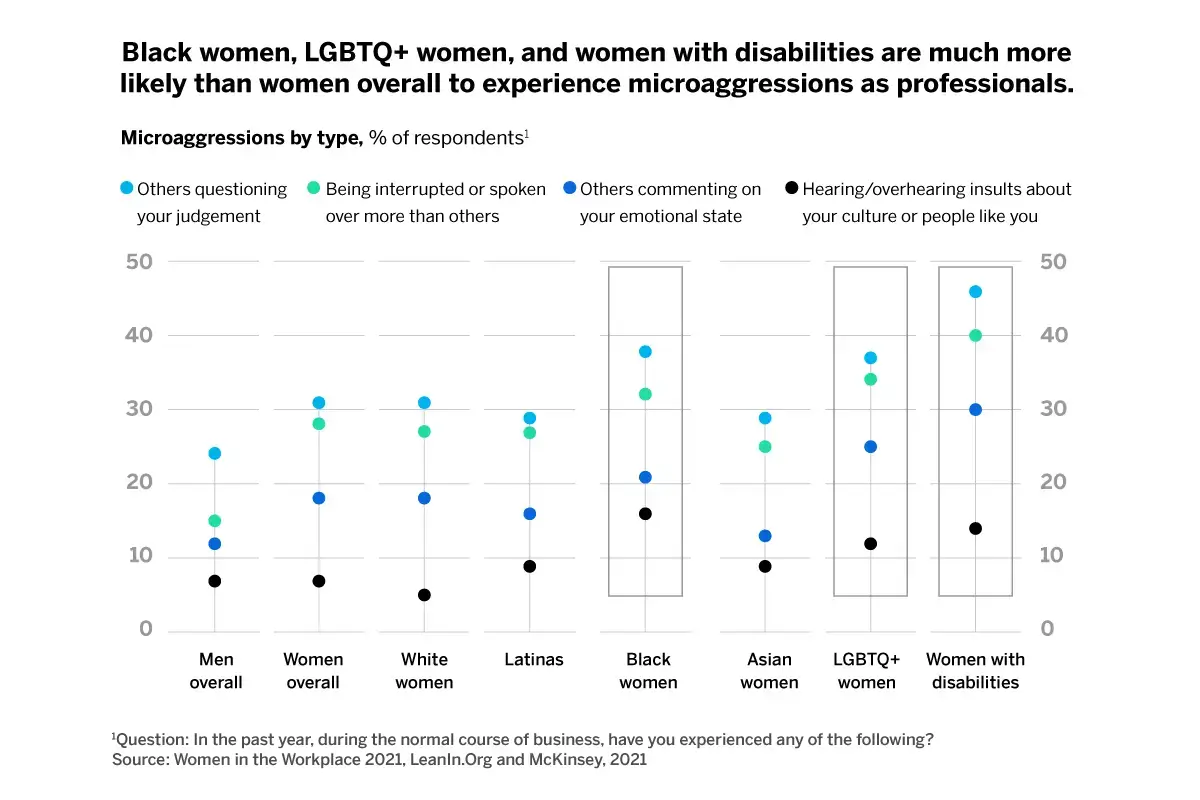
The business costs of gender discrimination in the workplace
As a business leader, of course, you must adhere to your legal responsibilities to eliminate gender discrimination. But in today’s climate, creating a working environment where all employees feel safe, secure, and that they belong, goes beyond legal box-ticking. Any form of discrimination creates a toxic work culture that affects everyone’s performance, and the business’s reputation. Employees will leave for more enlightened employers, pushing up your attrition rate, and making it difficult to attract and retain talented workers. And all these factors hit the bottom line of the business hard.
And when you ask women in the workplace what they believe is the single biggest disadvantage they face, they give a variety of answers:
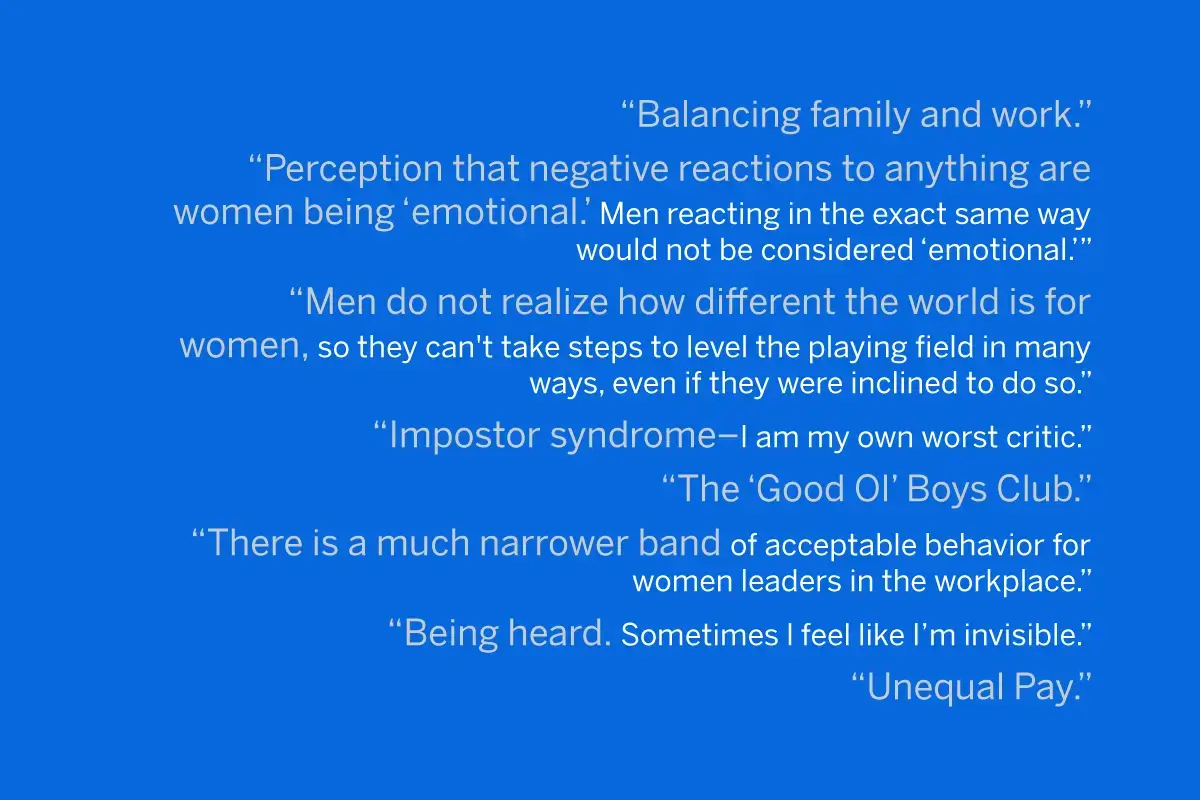
The benefits of more women in the workplace
It’s official – when there is a higher percentage of women leaders in the workplace, there is:
- More job satisfaction
- Less burnout
- More dedication to the business
- More meaning to the work
- Higher employee engagement
- More retention
And organisations whose workforce has a high percentage of women boast a positive work culture, work that is enjoyable, flexible work that fits with women’s work-life balance, and opportunities to make a difference in the world.
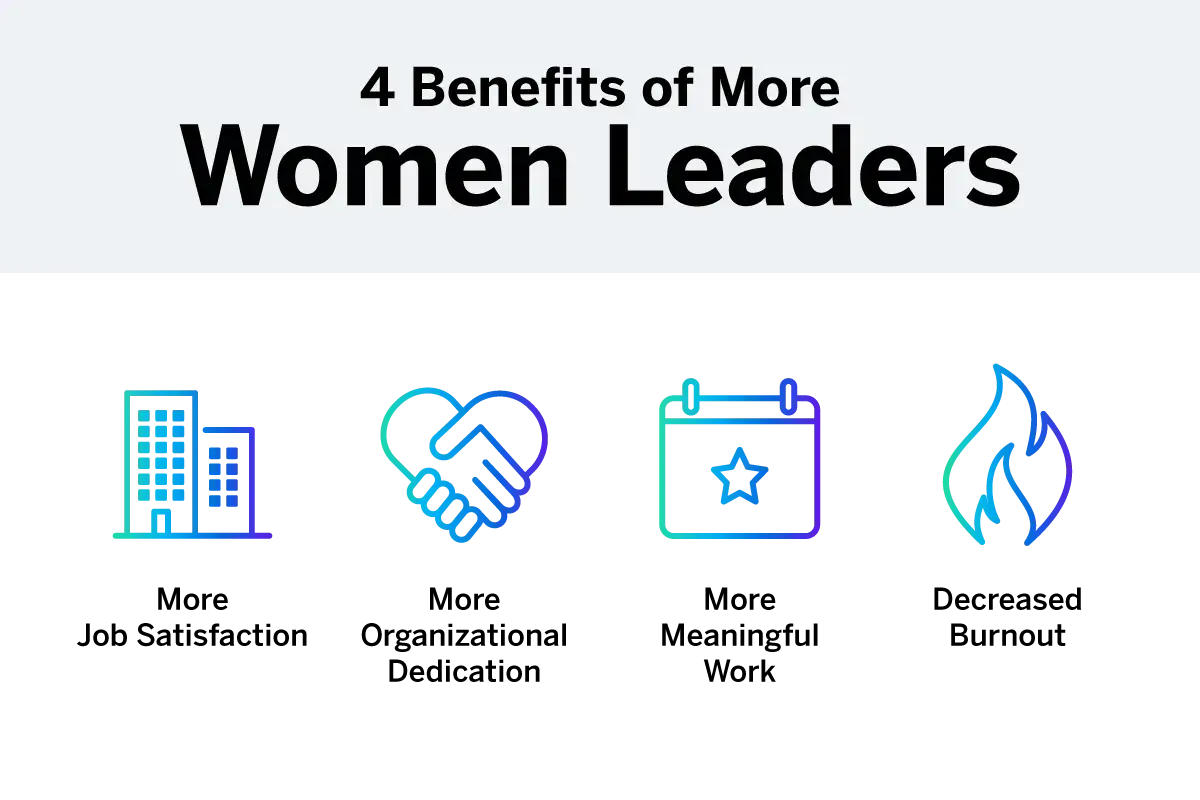
Countries with women leaders
Former United States President Barack Obama remarked, “If more women were put in charge, there would be less war, kids would be better taken care of and there would be a general improvement in living standards and outcomes.”
Throughout the pandemic, countries with women as heads of state have been recognised internationally for how effectively they responded to the crisis. Jacinda Ardern in New Zealand, Katrín Jakobsdóttir in Iceland, Angela Merkel in Germany, Mette Frederiksen in Denmark… all examples of women leaders who reacted to the virus threat in a proactive way, with early social distancing implementation, health strategies informed by medical experts, and compassionate, clear, communication that unified everyone in adversity.
And even though there are relatively few women leaders, it doesn’t take a pandemic to highlight how brilliant they are. Another study found that when venture capital firms increased female partner hires by 10%, they had a 1.5% increase in overall fund returns each year.
Women make good leaders because they:
- Have often overcome adversity, discrimination and barriers themselves, and are resilient, determined, and able to navigate tricky situations
- Bring diverse perspectives and experiences to the table
- Are often skilled at achieving consensus and fostering collaboration
- Demonstrate empathy and compassion, connecting with people on a personal level
- Are twice as likely as male leaders to spend substantial time on DEI work, with 40% saying their DEI work isn’t acknowledged at all in performance reviews.
- Support employee well being and welfare
The benefits of a diverse workforce
It’s well known that “the best workforce is a diverse workforce” (Ted Colbert, Executive Vice President of Boeing).
Diverse teams produce 19% more innovation revenue, according to one study:
By strengthening their commitments to diversity, equity, and inclusion (DEI) and belonging, companies also invest in their long-term success.
How to empower women in the workplace
While women are rising to be senior leaders in the C-suite of many companies, they are still underrepresented at all levels. Only 1 in 4 C-suite executives are women, and only 1 in 20 are women of color.
And women in the workplace can only get so far by self-promotion. Instead of watching senior women leave for jobs with more enlightened companies, modern businesses, in corporate America and beyond, must take responsibility for addressing bias, discrimination, and harassment, and empowering their female employees.
Here are our 10 tips:
1. Mend the ‘broken rung’
The “broken rung” (the first promotion step up from entry-level position to manager – too often missed) is still holding women back for the rest of their careers. For every 100 men promoted from entry level to manager, only 87 women are promoted, and only 82 women of colour are promoted.
2. Eliminate bias
Unconscious bias is present in every business, because we all have subconscious preferences based on opinions or experiences from our pasts: whether it’s outdated views on what constitutes ‘women’s work’ as opposed to ‘men’s work’, or feeling that an interviewee looks a little too much like your old school bully, and this may influence your opinion of them.
Here are some biases to be aware of and how to avoid them:
| Bias | Manifestation | Solution |
|---|---|---|
| Gender Bias | Treating one gender (generally women) more favourably than another | Consider a gender swap for each role. Would it make any difference? |
| Age bias | Assuming older employees are less capable or competent than younger ones | Create mixed-age teams where everyone benefits from the experiences and abilities of each other |
| Conformity bias | Like peer pressure, the group opinion can influence individuals to conform, rather than take a stand against it | Use anonymous surveys to gather opinions so everybody feels safe expressing what they really feel |
| Affinity bias | Assuming that people are drawn to others ‘like them’, maybe in gender, race, age, color, religion | Create a diverse workforce, and one that promotes diversity, through your hiring process |
| Name bias | Someone’s name may suggest their gender, race or religion and trigger a bias an employer may have about that person’s background | Remove applicants’ names during the recruitment process, focusing instead on qualifications and experience |
| Height/weight/beauty bias | Judging people based on their physical attributes | Look ONLY at a person’s qualifications and experience |
3. Talk to women – and listen
For too long, women – be they young women, senior women, Asian women, Black women, LGBTQ+ women – in the workplace have been sidelined, interrupted, talked over, and silenced by their male counterparts.
It’s essential to give women a voice by:
- Talking to all women in your organisation, whatever their level, and asking them about career development, flexibility, parental leave, working conditions for caregivers, upskilling, mentoring and organizational culture: What’s working? What isn’t? Who’s leaving? Why?
- Hearing what they have to say, equally, in meetings, and championing women’s great ideas and suggestions
- Choosing women speakers to stand up and present, both in house and externally, to build confidence and inspire other women
- Inviting inspirational women in to give talks for all employees, not just your female workforce, so that all genders can appreciate how amazing these women leaders are
- Holding panel events only when there can be an equal number of women and men present to reflect the range of ideas and thoughts from the perspective of both genders equally
4. Implement flexible working
When ‘balancing family and work’ is given as one of the major challenges facing women in the workplace today, it makes sense that flexible working should be available to all – and by ‘all’ we mean all genders taking responsibility for balancing work and life.
And post pandemic, it is likely that hybrid working will be here to stay in some capacity. One study found that the majority of women prefer remote or hybrid work to being fully on-site, and this preference runs deeper than flexibility: When women work remotely, they experience fewer microaggressions and higher levels of psychological safety. And women of colour and women with disabilities are about 1.5 times less likely to experience demeaning and ‘othering’ microaggressions when they work mostly remotely as opposed to mostly on-site.
Women particularly benefit from being able to take time out from their working day to care for children or elderly relatives, and work when it suits them. And as women generally are skilled at multitasking, they’ll get that work done, and done well. Flexible working allows women to balance their home and work responsibilities, while progressing their careers and continuing to develop.
5. Equal maternity and paternity leave
It can be tough for women to take a break from work after having children, and then return to the workplace. All too often, they miss out on pay rises, promotions, performance reviews, training, experience, and team dynamics. They may return to work to find their role may have changed, responsibilities altered, and even someone else taking credit for the work they had done previously.
When more organisations support both parents to be able to take an extended amount of maternity and paternity leave from work, this helps the couple balance their childcare needs. Extended parental leave across the board could have the added benefit of giving more men in the workforce the experience of a return post-leave, which in turn may help them to empathise with their returning female colleagues. Creating more equal opportunities here would really deliver meaningful and sustainable progress.
6. Equal pay for equal work
As we’ve seen above, the gender pay gap is still alive and kicking in workplaces globally. And the impact of it is far more than just financial. When women in the workplace feel cheated out of fair pay, they feel less valued, and people who feel less valued are disengaged at work. Employee engagement is essential for the success of a business, and alienating a substantial proportion of your workforce makes no business sense. Look in your data for inequalities and make sure all your employees, regardless of gender, are paid equally for equal work.
7. Make leadership diverse
In 2023, the number of women running Fortune 500 businesses reached an all-time record: 53.
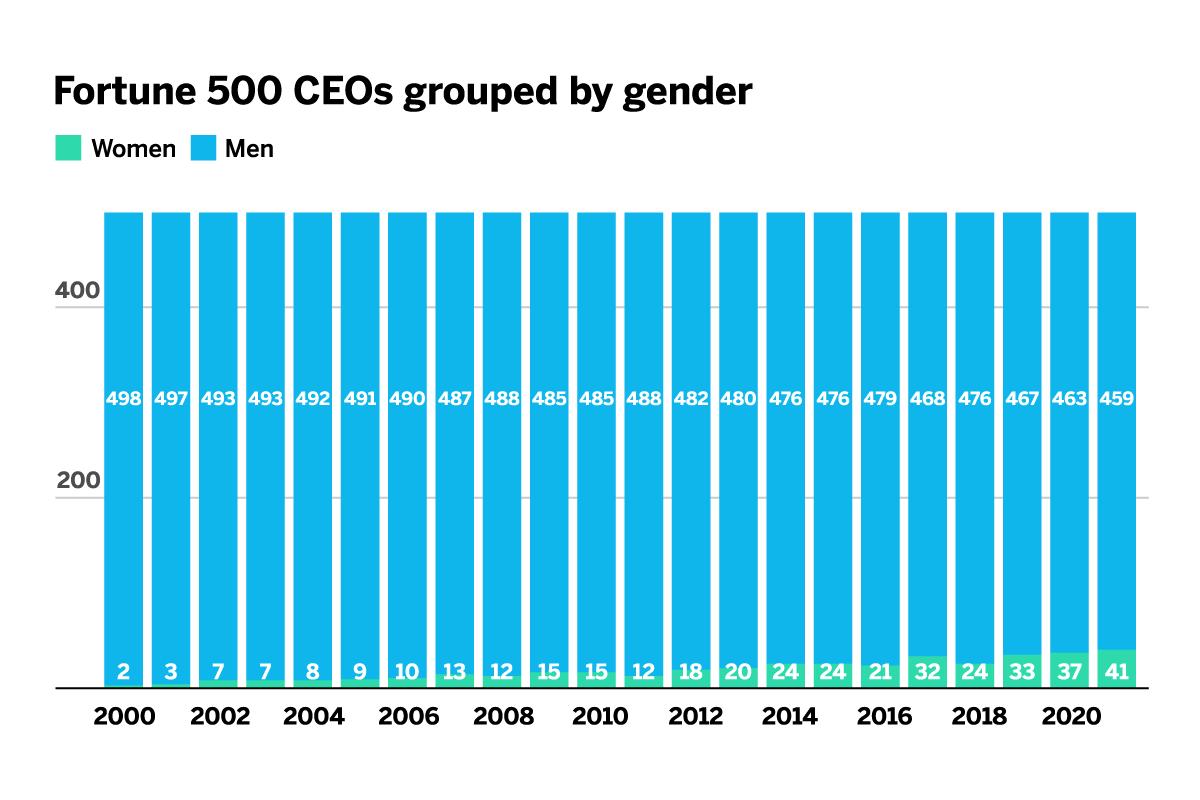
Just a few women of colour run Fortune 500 businesses:
- TIAA CEO Thasunda Brown Duckett,
- Walgreens Boots Alliance CEO Roz Brewer
- Advanced Micro Devices CEO Lisa Su
10% of the Fortune 500 is run by women, meaning that nearly 90% of the top companies are still run by men. https://www.shrm.org/executive/resources/pages/women-fortune-500-2023.aspx
There is clearly still much work to be done. Women are still expected to navigate the broken rung (that first, crucial step up to manager level) of the corporate career ladder, but the problem remains a systemic one, so…
8. Change those systemic obstacles that are holding women back
It’s not enough simply to slot women into an organisation’s current status quo. Systemic change goes beyond simply recognition, merely factoring women into conversations and initiatives, and making empty promises to pursue advancement opportunities.
At the moment, because organisations are generally run by men, the culture still leans towards a masculine way of working:
- Intense, long hours that men can work because they are generally not primary caregivers
- Getting ahead by socialising or a drinking culture
- Men being more present in the office rather than working from home because women tend to bear most of the caregiving responsibilities
Organisations need to listen to employees when they say ‘these are the obstacles standing in my way’ to understand and change the systemic things that are holding women back.
9. Celebrate individuals
The healthiest workplaces are those where employees feel they belong and can be their authentic selves at work. Celebrate the different qualities and skills that women in the workplace bring to their roles, recognising that everyone has their own story and they are shaped by that. Also recognise and celebrate women’s accomplishments across the organisation, not just within the department, to inspire other female employees to follow in their footsteps.
10. Gather and analyse data on gender representation
Use surveys and employee listening to understand the gender representation in your company and its culture:
- Do men significantly outnumber women?
- Does what the business trumpets about its culture line up with what employees are really experiencing?
- Is there a difference in experience based on an employee’s gender?
- Are your meeting cultures, committee work and corporate socialising welcoming and inclusive of everyone?
- Are there reasons women leaders don’t stay long?
Use the data you collect and analyse to be a starting point for identifying the systemic problems in your business that hold women back, then take action to eliminate them and create a fair and equitable business.
Empower women in the workplace with Qualtrics™
The two most important things to do to empower women in your workplace are: to listen to them, then change the systemic problems holding them back.
Free eBook: How to apply DEI to your employee experience program